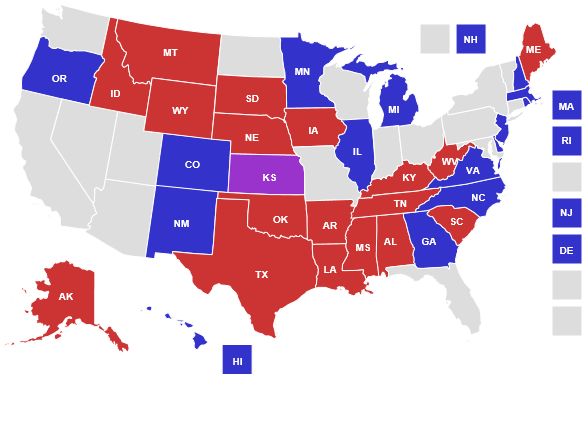The Fight for the Senate: Who Will Win Control?

The main talk of the 2014 election has been which political party will control the Senate after the votes have been counted. Democrats have been on defense throughout most of the country as President Obama's approval rating remains low. So with just a week to go before Election Day, how will the numbers fall? Here are my predictions.
In this election cycle, Democrats have 38 seats that are safe or not up for re-election while Republicans have 42. So that is where my numbers start.
Democrats are projected to win the elections in Illinois (Durbin), Michigan, Minnesota (Franken), New Jersey (Booker), New Mexico (Udall), Oregon (Merkley), and Virginia (Warner). Republicans are safe in the elections in Mississippi (Cochrane), South Dakota, and West Virginia. This brings the total to 45-45 with 10 states that will determine the balance of the Senate.In their latest forecast, Nate Silver and those at fivethirtyeight.com give the Republicans a 62.1 percent chance of retaking the Senate. The race is on for either side to grab 6 of the 10 toss-up seats. It is going to be close, and it might just hinge on one thing we would not have predicted even 6-months ago.
It seems likely that Republicans will win seats currently held by Democrats in Alaska, Arkansas, Iowa, and Louisiana. Though Democratic U.S. Senator Mary Landrieu (Louisiana) will win on November 4, she will not cross the 50 percent threshold, sending the top two candidates into a run-off in December. in which she will fall. Republicans will also hold on to the seat in Kentucky. This gives the GOP a total of 50 seats.
So what about the Democrats?
I believe the Democratic Party will hold on to their seats in New Hampshire and North Carolina. I've watched over the polls of Colorado, and they have given me a headache just as they did during the 2012 election. I will go out on a limb that Colorado will stay in the Democratic column, but just barely.
There is still a state that was a surprise for this grouping. Even a month ago, I had not included it here, but my gut tells me to do so now -- Georgia. Again, I believe this will be extremely close, but that the Democrat will come out on top. Total for the Democrats: 49.
This leaves one seat remaining. Republicans need it for control; Democrats need it for a tie with Vice-President Biden (Democrat) being the tie-breaker. I hinted at this earlier, and it is Kansas.
As the election year started, Republicans saw Sen. Pat Roberts sitting in a safe seat. He had a tea-party challenge in the primary, which he defeated. He was being challenged by the Democrats and an independent candidate, Greg Orman.
Then, the Democrat, Chad Taylor, basically seeing the writing on the wall, dropped out leaving only Orman to challenge Sen. Roberts. The race has tightened up, but I'm predicting that Orman will pull off the upset and join independents Bernie Sanders (Vt.) and Angus King (Maine) in the Senate.
So it will come down to where Orman caucuses: with the Republicans to give them majority or with the Democrats to give them a tie (and thus majority off the tie-breaker).
This is how close it is going to be. The Senate will be 50-50 or 51-49 Republican. The Senate may need to learn how to compromise and function a little bit better with the chamber so evenly divided. Despite all the polls and predictions, it will all still be determined by who shows up to vote. So make sure to vote on November 4.
Author's note: This column is my sole opinion based off examining various polls.




